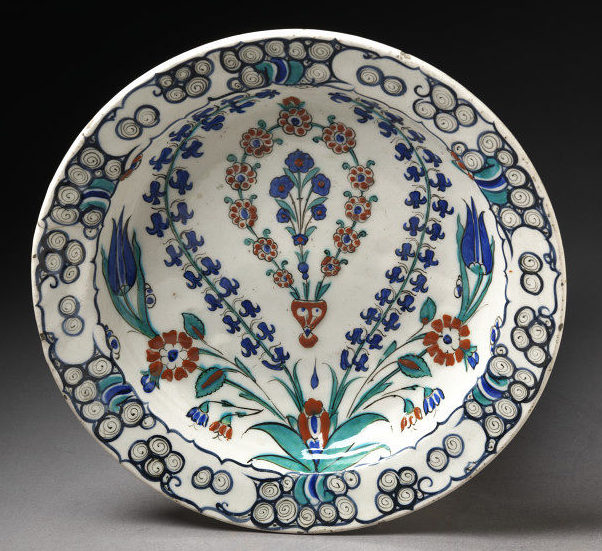The symmetrical floral composition on the dish is one of the most marked features of a number of Iznik plates of the period between 1550-1565. From a purely doctrinal viewpoint, the aesthetics of symmetry derives from the Islamic notion of cosmic balance (mizan) and the harmony of the Creation, as represented in several passages of the Qur’an:
And the heaven He raised and imposed the balance, That you not transgress within the balance. And establish weight in justice and do not make deficient the balance.
(Qur’an, Surat Ar-Raĥmān [The Beneficent], verses 5-9)
The symmetrical floral composition on The Courtauld’s Iznik dish has a remarkable dynamic movement, whereby the flowers are encircling the tulip. The rhythmic floral circles projects the Sufi ‘whirling’ dance, a hallmark of the Ottoman Mawlawıya Sufi order which was prevalent in the 16th century.

It has been suggested that Iznik craftsmen were members of Sufi orders, and that Dervish lodges and saints’ mausoleums were probably centres of religious practice and sociability for many artisans.[1]
The Sufi tradition prefers orderly, symmetrical arrangements in general, and purely circular forms in particular. The circle (da’ira, halaqa) is sacred and the circular motion connects to the world of the spirit. Circles are seen as a symbolic imitation of pilgrims orbiting the Ka’aba in Mecca, and the planets orbiting the sun.
Using the methods of textual analysis, it is possible to interpret the floral composition of the dish in terms of Sufi spirituality. In this vein, the composition echoes the whirling Sufi dance, which, involves some form of circle formation with oscillating, swaying movement, around, into and out of the circle.
Occasionally an individual participant will step into the middle of the circle […] and performs his whirling in the middle while the members of the host group form concentric circles around him.[2] The whirling flowers are perpetually dancing in mystical circles, ever inwards, until a deep peace may be felt to be centred upon the tulip, the symbol of divinity.
References
[1] Suraiya Faroqhi, (2009). Artisans of Empire: Crafts and Craftspeople Under the Ottomans (London:I.B.Tauris & Co. Ltd).
[2] John Renard, (2009). The A to Z of Sufism. The Scarecrow Press, Inc. Plymouth, UK, p.68.
Back to Iznik Dish

